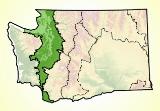 © Pete Saloutos/Panoramic Images (Washington Title Image Large)
© Pete Saloutos/Panoramic Images (Washington Title Image Large)

Puget Trough: People in the Ecoregion
The earliest archaeological evidence of people in the Puget Trough ecoregion dates to about 8,000 years before present, at the mouth of the Fraser River in British Columbia and along the lower Columbia River. The ancestors of the Salish or Salishan-speaking peoples flourished in the region and developed into eighteen or more linguistic traditions.
These peoples created prosperous maritime cultures that employed the rich biodiversity of the region.
Key resources included:
- Salmon and shellfish for food and tools
- Cedar for housing, clothing, and canoes
- Plants such as nettle, bracken fern, berries, rice root, and camas for food and fiber.
Europeans, and later Americans, also made use of the marine and forest resources of the Puget Trough ecoregion. Land use patterns were established early.
As of 1991, more than 50% of the Puget Trough had been converted to urban and agricultural uses. Rural areas in the Puget Trough are managed largely for intensive industrial and private forestry. Pasture and cropland are also dispersed throughout the ecoregion.
In 1999, the ecoregion’s population was nearly 3.9 million—double that of the 1960s. By 2020 the population in the Puget Trough is expected to grow to 5 million. This increasing population is putting pressure on the remaining natural areas and on working lands.
Around Vancouver, Clark County’s population is rapidly growing. From 1990 to 1997 it increased 33%—tops for the state during that period.
Puget Sound itself suffers from pollution and other ills. The Endangered Species Act listing of Puget Sound’s wild Chinook salmon was the first to affect such a major urban area. The Puget Sound southern resident orca population has also been listed as endangered.
Although altered and under stress, both the terrestrial and marine environments of the Puget Trough ecoregion are still extremely productive.
For details of this ecoregion within Washington, click a subheading in the left column.
View the more general description of this ecoregion in North America



